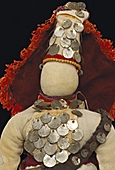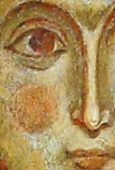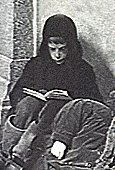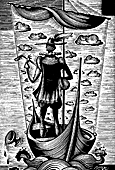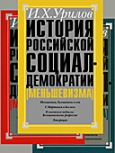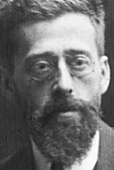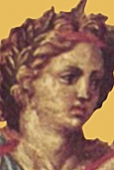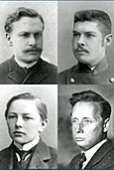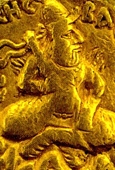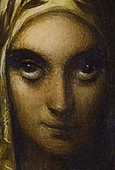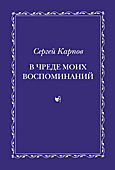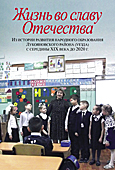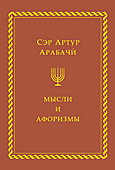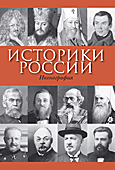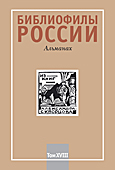A Note on Persian Names Puptis and Vartic
Akbarzadeh D.
Middle Persian northern languages affected New Persian literature strongly. Also Great Khorasan’s dialects have preserved some linguistic features of those languages (eastern). While the Sogdian language was studied since long time ago but I have stressed on a new aspect of research in this note.
The two bird names, Hoopoe and partridge, have been preserved as Pup/butis and Vartic by eastern dialectical texts and dialects. The author supposes that there is a linguistic relation between the suffixes in Pup/ butis and Vartic and Sogdian -tyak in the terms like ywry’ty’kh. The author believes that the northeastern suffixes -tis and -tic and Sogdian -ty’kh are the same and from a single form. Also I suggest that the function of the suffix was “noun-maker” and maybe “adjective-maker” in the past.
Принцип административного деления в ахеменидской Персии
Хорикян О.Г.
В специальной литературе последовательность перечисления сатрапий всегда вызывала разногласия. После подавления восстаний против Дария I административные реформы начались с Малой Азии, потому что ни одна страна, находящаяся к западу от Евфрата, не восстала против Дария. В статье показано, что последовательность перечисления сатрапий обусловлена хронологической очередностью их формирования, состоявшей из пяти этапов.
H.G.Khorikyan (Yerevan). PRINCIPLE OF ADMINISTRATIVE DIVISION IN ACHAEMENID PERSIA
The enumeration sequence of the Satrapies in professional literature has always caused controversy. After the formation of the Satrapies in relatively peaceful regions of the Empire to the west of the Euphrates, the attention of the Persian Court already focuses on those countries which had not adopted Darius’ royal power and had rebeled against it.
The investigation shows that the enumeration sequence of the Satrapies is determined by their chronologic formation order, which has taken place by five phases.
Нумизматические данные к политической истории Согдианы (IV-II вв. до н.э.)(Addenda et Corrigenda)
Атаходжаев А.Х.
В статье предлагается информация о новых находках эллинистических монет в Согдиане - древней историко-географической области Средней Азии. Нумизматические данные служат неоспоримым свидетельством включения этой области в состав Селевкидского царства в IV-II вв. до н.э. На основе комплексного анализа исторических сведений, археологических исследований и данных нумизматики предлагается корректировка исторической реконструкции событий, связанных с начальным этапом выделения Греко-Бактрии в самостоятельное царство.
A.Kh.Atakhodjaev (Samarkand). NUMISMATIC DATA FOR THE POLITICAL HISTORY OF SOGDIANA IV-II CENT. B.C. (ADDENDA ET CORRIGENDA)
The article provides information on new finds of the Hellenistic coins in Sogdiana, an important historical and geographical region of ancient Central Asia. Numismatic data are indisputable evidence of the inclusion of this area in the Seleucid kingdom in the IVth-IIrd centuries BC. On the basis of a comprehensive analysis of historical information, archaeological research and numismatic data is offered an adjustment to the historical reconstruction of events related to the initial stage of the allocation of Greco-Bactria into an independent kingdom.
Сцена борьбы со змееморфным демоническим персонажем на оттиске печати староассирийского периода из собрания ГМИИ им. А.С. Пушкина (I 2 Б 1591)
Немировский А.А.
Шелестин В.Ю.
Ясеновская А.А.
Статья посвящена публикации оттиска староассирийской печати из Кюль-тепе, несущего крайне редкую для переднеазиатского изобразительного искусства сцену борьбы героя со змееморфным чудовищем (по-видимому, двуглавым змеем). Печать относится к числу немногочисленных высоко оригинальных артефактов из Кюль-тепе (большинство печатей оттуда несет, напротив, мотивы, многократно повторяющиеся на других печатях из самого Кюль-тепе и иных центров). Такая интерпретация сюжета детально подтверждается фотографиями и находит ряд аналогий в глиптике и на иных артефактах клинописных культур III-I тыс., существовавших в месопотамском и сиро-анатолийском регионах. Ближайшие аналогии змею на оттиске представляет, по-видимому, змей на позднехеттском рельефе из Малатии, что позволяет говорить о существенной роли анатолийских представлений в формировании композиции, представленный на печати. Вопрос о конкретном змееборческом мифе, переданном этой композиции, остается открытым.
A.A.Nemirovsky, V.Yu.Shelestin, A.A.Yasenovskaya (Moscow). SCENE OF STRUGGLE WITH DRAGON-LIKE DEMONIC PERSONAGE ON THE STAMP OF OLD-ASSYRIAN PERIOD FROM THE COLLECTION OF PUSHKIN-MUSEUM (I 2 Б 1591).
The paper presents publication of an old Assyrian seal print from Kultepe carrying a scene of a hero’s struggle with a serpent-like monster (apparently two-headed one), which is extremely rare for the Anciemt Near Eastern art. The composition is one of the few highly original ones from Kultepe (most of the seals found there bear, on the contrary, motifs repeated many times on other seals of this place and times). Our interpretation of seal print in question is confirmed in detail by its photographs and has a number of analogies in the glyptic and other artifacts of cuneiform cultures of the Mesopotamian and Syro-Anatolian regions in the 3rd - 1st Mills BC. The closest analogy to the serpent on our seak print is apparently a serpent (apparently two-headed) on the Late Hittite relief from Malatia, which fact allows us to trace a significant role of Anatolian traditions in the formation of the composition presented on our seal. The question of the specific myth reflected in this composition remains open for now.
Храм огня V-IV вв. до н.э. Кизылтепа
Сверчков Л.М.
Ву Син
До недавнего времени многие исследователи зороастризма не находили убедительного объяснению отсутствия храмов данной религии на территории бывшей Ахеменидской империи (VI-IV вв. до н.э.). За последние десять лет в Сурхандарьинской области Узбекистана обнаружены и полностью раскопаны два храмовых комплекса середины I тыс. до н.э. Одним из них является храм Кизылтепа - ядро одного из крупнейших в Северной Бактрии городищ ахеменидского времени, результаты раскопок которого представлены в настоящей статье. В первую очередь приводятся данные по архитектурно-планировочной структуре, а также стратиграфия, периодизация и хронология памятника, во вторую - некоторые выводы общеисторического характера, основанные, на конкретных материальных свидетельствах. Прежде всего, это касается греко-македонского завоевания Северной Бактрии в 329-328 гг. до н.э. и его последствий.
L.M.Sverchkov (Tashkent, Uzbekistan), Wu Xin (Shanhai, China). THE TEMPLE OF FIRE V–IV BC KYZYLTEPA
A part of the article presents is the result of archeological investigations of the ancient Bactrian town of Kizyltepa in the Southern Uzbekistan. Its area is about 13–14 hectares, the core of the monument is the “citadel” located between the river channels, along the banks of which once rose the estates of the local nobility. “Citadel” is a large monumental structure in the form of a non-regular pentagon of 100 × 75 m, directed in the north by one of its angles. Interior on both sides was equipped with three-stage platforms similar to a Classical amphitheater, but in the traditional oriental style - with ivans.
In the south-west comer of the amphitheater on a high hill stood a building, the excavations of which unearthed the ruins of the temple of fire that existed in three stages somewhere from mid-V to the end of the IV century BC. Its size is 22.5 x 18 m, inside there was a square sanctuary with an altar of fire surrounded by a bypass corridor with three pits for ritual cleansing. In the corner of the central room there was located a specially designed exit to the second floor, which, taking into account design values, allows reconstructing the appearance of a temple in the form of a three- stage zikkurat.
Due to the Greco-Macedonian invasion 329-328 BC the temple was desecrated and destroyed. After that the survived population sealed the ruins with powerful and extremely labour-intensive brick masonry - a kind of burial sarcophagus, in which the altar of the sacred fire rested forever.
Река Guthalus и восточная граница расселения готов в Южной Прибалтике в эпоху Плиния и Тацита
Казанский М.М.
Плиний, при описании южного берега Балтики (77-79 гг. н.э.), упоминает к востоку от Вислы реку Гутал (Guthalus), неизвестную другим античным авторам. Поскольку навание реки явно отражает этноним «готы», то вероятнее всего данная водная артерия либо как-то связана с территорией этого народа. В данной статье сделана попытка идентифицировать эту реку с помощью археологических данных о расселении готов, то есть с территорией культуры Вельбарк, которая включает в себя бассейн Нижней Вислы, на обоих берегах реки. В интересующем нас регионе к востоку от Вислы, где расположен Гутал, памятники вельбаркской культуры занимают зону между Вислой и Пасленкой / Пассарж. Поэтому Гуталус может быть идентифицирован как река Пасленка, маркирующая восточную границу готического поселения на юге Балтийского региона.
M.M.Kazanski (Paris). RIVER GUTHALUS AND EASTERN FRONTIER OF THE SETTLEMENT OF GOTHS IN SOUTHERN BALTIC REGION IN THE TIME OF PLINY AND TACITUS
Pliny the elder, in describing the southern shore of the Baltic Sea (77-79 AD), mentions “famous” rivers falling into the Ocean (Baltic Sea): Guthalus, Visculus sive Vistla, Albis, Visurgis, Amisis, Rhenus, Mosa (Naturalis historia, IV.100). All of them, with the exception of Guthalus, have been identified. In this paper, an attempt is made to identify this river with the help of archeological data. Guthalus is the only known river in the Baltic basin east of the Vistula. The name Guthalus reflects the ethnonym of the Goths and is probably the eastern border of the settlement is ready. We can compare the river Pliny with a map of Gothic antiquities of Roman times. The archaeological culture of Wielbark is considered German, and even specifically Gotho - Gepidic. The territory of Wielbark culture includes all the Lower Vistula, on both banks of the river. In the region of interest to us, east of the Vistula, where the Guthalus is located, the sites of the Wielbark culture between the Vistula and Pasłęka / Passarge. Therefore, Guthalus can be identified as Pasłęka / Passarge. It marks the eastern boundary of the Gothic settlement in the southern Baltic region.
Импортные бронзовые кованые котлы Азиатской Сарматии
Трейстер М.Ю.
Значительная часть бронзовых котлов из Азиатской Сарматии - литая и была изготовлена местными ремесленниками, тогда как котлы с кованым туловом и литыми ручками из погребений кочевников Азиатской Сарматии II в. до н.э. - III в. н.э., относящиеся к западным импортам, рассматриваются в данной статье. Помимо редких образцов котлов, изготовленных еще в IV-III вв. до н.э. в Македонии или Эпире, один из которых найден на Среднем Дону в комплексе конца II-I в. до н.э., в эту эпоху к кочевникам попадали котлы, вероятно, изготавливавшиеся в мастерских Малой Азии или Боспорского царства, в том числе экземпляры с греческими владельческими надписями. Тезис Б.А. Раева о том, что бронзовая посуда не изготавливалась в причерноморских мастерских, а импортные сосуды были привезены или из Италии, или из Фракии, или производились в мастерских Северного Кавказа или Закавказья, не выдерживает критики. Значительно более сложной вырисовывается картина с распространением бронзовых кованых котлов в Азиатской Сарматии и во II-III вв. н.э. Котелки так называемых групп Дебелт и Ровное, которые, по мнению Б.А. Раева и С.В. Демиденко, вначале изготавливались в италийских, а затем - провинциально-римских мастерских или на Северном Кавказе и в Закавказье, как показал наш анализ, с высокой степенью вероятности производились в боспорских мастерских. Такое преобладание среди импортных котлов у кочевников Азиатской Сарматии предположительно боспорской продукции не исключает того, что к ним могли попадать и отдельные экземпляры их Римских провинций, о чем свидетельствует находка в Нижнем Поволжье котла, который, судя по надписи, был изготовлен во Фракии.
M.Yu.Treister (Bonn). IMPORTED BRONZE HAMMERED CAULDRONS FROM ASIAN SARMATIA
A significant part of bronze cauldrons found in Asian Sarmatia is cast and was made by local craftsmen, whereas those from the nomadic burials, dating from the 2nd century BC to the 3rd century AD, with hammered bodies and cast handles, belonging to western imports, are discussed in this paper. In addition to a rare example made in the 4th - 3rd centuries BC in Macedonia or Epirus, found in the Middle Don basin in the complex of the late 2nd - 1st century BC in the late 2nd - 1st century BC nomads received cauldrons, probably made in the workshops of Asia Minor or the Bosporan kingdom, including those with Greek ownership inscriptions. The hypothesis put forward by B.A. Raev that bronze ware was not manufactured in the Black Sea workshops, and imported vessels were brought either from Italy, or from Thrace, or were made in workshops
of the North Caucasus or Transcaucasia, does not stand up to criticism. Significantly more complex picture in comparison with those drawn in previous publications emerges with the distribution of bronze hammered cauldrons in the 2nd - 3rd centuries AD. Most widespread were the cauldrons of the so-called Debelt and Rovnoe groups, which according to B.A. Raev and S.V. Demidenko were manufactured in Italian, and then in Provincial- Roman workshops or in North Caucasus and Transcaucasia. Our analysis shows with a high degree of probability their possible manufacturing in the Bosporan workshops. Such a preponderance of presumably Bosporan products does not exclude that certain pieces could find their way from the Roman provinces, as evidenced by the find in the Lower Volga area of a vessel with a Greek inscription pointing to Thrace as the place of its manufacture.
Sur une famille de noms paphlagoniens attestes dans le royaume du Bosphore
Avram A.
The author collects evidence for anthroponyms belonging to the family
of Κ(ο)υλ(λ)- in inscriptions from Asia Minor and the North coast of
the Black Sea. He remarks that their area of concentration is Paphlagonia,
therefore, these names, obviously of Hittite origin, belong to Paphlagonian
stock. Their presence in the Bosporan Kingdom, at Olbia and at Chersonesus
Taurica can be explained through a rather early wave of migration (before the 4th century BC) coming from Paphlagonia (see Tokhtas’ev 2007). To the same family could also belong the name Γολας (alternance k/g in Hittite-Luwian, possibly also in Paphlagonian).
Неизданный памятник из Восточно-Крымского историко-культурного музея заповедника (КЛ-1465)
Бехтер А.П.
Кучеревская Н.Л.
В статье публикуется ранее не издававшаяся надгробная стела конца V - первой половины IV в. до н.э., переданная местной жительницей Керченскому музею еще в 1978 г.
A.P.Bekhter, N.L.Kucherevskaya. UNPUBLISHED MONUMENT OF THE EAST-CRIMEA MUSEUM-RESORT FOR HISTORY AND CULTURE (KL-1465)
The article presents an early unpublished funerary stele, dated by the end of the Vth - forst half of the IVth century B.C., passed to the Museum by a local inhabitant still in 1978.
Древности Стефана Верковича в Государственном Эрмитаже
Букина А.Г.
Гуляева Н.П.
Горская О.В.
В 1870-е - 1880-е гг. для пополнения коллекций Императорского Эрмитажа при помощи Императорской Археологической Комиссии было приобретено несколько античных предметов, которые, со слов продавца, были найдены в Македонии - в окрестностях реки Струмь и в районе античной Эгнатиевой дороги. Продавцом выступал Стефан Ильич Веркович (1821-1894). Исследования архивных материалов Верковича и документов Министерства Императорского Двора и Эрмитажа позволили идентифицировать эти антики в современной коллекции музея. Атрибуционные и технико-технологические исследования выявили среди древностей Верковича как подлинные произведения греческого и римского художественного ремесла, так и подделки Нового времени. История древностей Верковича красочно иллюстрирует относящийся ко второй половине XIX века этап развития отечественной культуры собирания античных археологических памятников и античной археологии в целом, а также русско-югославские культурные контакты того периода.
A.G.Bukina, N.P.Gulyaeva, O.V.Gorskaya (St.-Peterburg). ANTIQUITIES OF STEPHAN VERKOVIC IN STATE HERMITAGE
In the 1870s and 1880s Imperial Hermitage with the help of the Imperial Archaeological Commission purchased some antiquities to replenish its own collections. They were said by the seller to have been found in Macedonia - in the vicinity of the river Strum and in the area of the ancient Egnatia Road. The seller was Stefan Ilyic Verkovic (1821-1894). Investigation of archival materials of Verkovic and documents of the Ministry of the Imperial Court and Hermitage allowed the identification of these antiques in the museum’s contemporary collection. Attribution and technological research revealed among antiquities of Verkovic as genuine works of Greek and Roman artists and craftsmen, as well as modern fakes. History of Verkovic antiquities colorfully illustrates the stage of development of the national culture of collecting ancient archeological monuments and ancient archaeology in general, as well as Russian-Yugoslav cultural contacts of the second half of the 19th century.
О преобразовании ономастического материала в полноценный исторический источник (на примере нового магического опистографа из Ольвии)
Николаев Н.И.
Выдающемуся ученому Сергею Ремировичу Тохтасьеву не суждено было решить им же поставленную амбициозную задачу по преобразованию ономастического материала в полноценный исторический источник в условиях, когда традиционных источников знаний или не хватает или они отсутствуют вовсе. В статье предлагается вариант частичного решения этой задачи для одного из самых значительных полисов Северного Причерноморья - Ольвии. На примере изучения списка имен из нового магического опистографа обоснованы перспективы и показаны проблемы использования просопографии (синхронизированного эпонимного каталога IosPE I2 201) в датировании и исторической интерпретации некоторых магических надписей Ольвии. Присутствие в списке имен известных исторических лиц, в том числе, эпонимов, дедикантов и магистратов середины IV в. до н.э. преобразует опистограф в полноценный исторический источник. Магический памятник, датируемый 357347 гг. до н.э. и содержащий, в том числе, ретроградный стиль письма, является интересным объектом для последующих палеографических, ономастических и лингвистических исследований.
N.I.Nikolaev (Nikolaev, Ukraine). ON THE TRANSFORMATION OF ONOMASTIC MATERIAL INTO A FULL-FLEDGED HISTORICAL SOURCE (ON THE EXAMPLE OF A NEW MAGICAL OPISTOGRAPH FROM OLBIA)
S.R. Tokhtasyev formulated the task to learn the way of transformation of onomastic material into a full-fledged historical source when there’s the lack of traditional sources of knowledge or they are completely absent. I suggest a partial solution of this task for one of the most significant ancient states of the Northern Black Sea region - Olbia. A new magical opisthograph is studied in the article. The prospects are grounded and the problems of using prosopography (a synchronized eponym catalog) in the dating, interpretation and reconstruction of some of the magic inscriptions of Olbia are revealed. Earlier, the similar conclusion was made for the monograms and legends of the Olbian coins, agranomic stamps, weights and lapidary inscriptions with the names of the citizens of Olbia. Historical figures, acting in the third quarter of the 4th century BC are identified. The chronological and prosopographic relationship of the opistograph with a large group of epigraphic monuments confirms the validity of the previously constructed model of the Olbian community. The opisthograph dating 357-347 years BC is an interesting object for subsequent paleographic, onomastic and linguistic studies. So, some part of Olbian magic inscriptions contains onomastic information, which can be transformed into a full-fledged historical source which is commensurate in its information content with the lapidary archive and making a whole with it.
Еще раз о Меотиде как озере
Подосинов А.В.
Речь в статье идет об «озерности» Азовского моря, называвшегося в античности Меотийским озером (ἡ Μαιῆτις λίμνη, lacus Maeoticus) или Меотийскими болотами (paludes Maeoticae), или же просто Меотидой (Μαιῶτις, Maeotis). При том, что большинство античных авторов признавали Меотиду продолжением и оконечностью Нашего (Средиземного) моря от Гибралтара до Дона и знали о его «морской» солености и о его соединении с Черным морем через пролив Боспор Киммерийский (Керченский пролив), тем не менее его «озерность», закрепленная уже в названии, регулярно проявлялась в различных его описаниях и изображениях.
A.V.Podosinov (Moscow). ONCE
AGAIN ON THE MAEOTIS AS A LAKE
The article discusses the reasons why the Sea of Azov, which in reality is a sea and part of Our Sea, was often referred to in ancient literary tradition and in cartography as a “lake” or “swamps” (ἡ Μαιῆτις λίμνη, lacus Maeoticus, paludes Maeoticae). In my opinion, Maeotis was, apparently, perceived as a delta (estuary) lake of a powerful and important river – the Don-Tanais. This might be evidenced by the fact that from antiquity and the Middle Ages, many testimonies have reached us that Tanais “flows” into Pontus Euxinus (the Black Sea), and not into Maeotis (the Sea of Azov). It is confirmed by the analysis of words “lake” and “swamp” in ancient geography, especially in the works by Strabo, Mela and Pliny. We see the same situation in Pliny’s description of the Dnieper-Bug estuary, which he calls a “lake” (NH IV, 82), in the description by Strabo (XI, 2, 9–10) and Pseudo-Arrian (PPE 64) of the Taman Bay in the Kerch Strait, Lake Halmyris in the Danube Delta in Pliny (NH IV, 79), as well as Lake Flevon at the northern bed of the Rhine delta, mentioned by Pomponius Mela, Pliny and Tacitus.
Граффити из раскопок городища Чайка в Северо-Западном Крыму (2006-2008 гг.)
Сапрыкин С.Ю.
Попова Е.А.
Статья представляет собой публикацию граффити, найденных во время раскопочных сезонов 2006-2008 годов на городище Чайка в Северо-Западном Крыму. Это в основном торговые метки на керамике, преимущественно на амфорах, акрофонические цифровые граффити с обозначением объема пифосов, ценовые отметки, владельческие граффити. Надписи датируются III-II вв. до н.э. К статье прилагаются новое чтение опубликованного ранее граффито - «посвящения моряков», а также граффити с именами Дионисия и Диоскурида, известные по общим публикациям археологических комплексов Чайки, но не разобранные и не прокомментированные как эпиграфические источники.
S.Yu.Saprykin, E.A.Popova (Moscow). GRAFFITI FROM EXCAVATION ON THE SITE OF TCHAIKA IN THE NORTH-WEST CRIMEA (2006-2008)
The article is a publication of graffiti on pottery, found in course of excavation seasons 2006-2008 in the North-West Crimea on the site of Tchaika which belonged to the chora of Tauric Chersonesus. They are mostly commercial marks on pottery, chiefly on amphoras and kitchen ware, acrophonic numerical graffiti which indicate the capacity of pythoi and amphoras, prices, owners’ marks. Some of them give the owners’ names. The inscriptions are dated to the 3-2 centuries BC. There is also an Addenda where the authors give a new reading of the so-called “dedication of sailors” which had been published earlier, as well as the restoration and commentary of graffiti, bearing the names of Dionysios and Dioscurides. The latter are known from common publications of Tchaika archaeological complexes but were left unstudied and without any commentary as important epigraphic sources.
Боспорские жрицы
Скржинская М.В.
В статье собраны эпиграфические и материальные свидетельства о боспорских жрицах периода классики и эллинизма. Они исполняли различные ритуалы в культах Деметры, Афродиты, Артемиды, Кибелы, Диониса и обожествленных боспорских царей. Вероятно, некоторые жрицы ездили в Аттику и проходили разные этапы посвящения в Элевсинские таинства, а затем на родине воспроизводили увиденные во время мистерий ритуалы на празднествах в честь Деметры и Коры. Одна и та же женщина в разное время могла служить жрицей разных богов.
Боспоряне регулярно видели жриц в святилищах у алтарей и во время праздничных шествий по улицам городов. Жрицы из царского рода и из богатых семей делали ценные подношения богам. Праздничный наряд жриц включал одежду с разноцветными вышивками и нашивными бляшками с разнообразными рельефными изображениями. Убор дополнялся модными в то время ювелирными украшениями; некоторые из них делали приезжавшие на Боспор первоклассные ювелиры. Драгоценности и отдельные культовые сосуды были собственностью жрицы, и поэтому их могли положить в могилу как дорогие для женщины предметы и как напоминание о ее служении богам.
M.V.Skrzhinskaya (Kiev). BOSPORAN PRIESTESSES
The author analyses epigraphic and archeological sources which give precise information about Bosporan priestesses. They performed various rituals in cults of Demetra, Aphrodita, Artemida, Cybela, Dionysus and deified Bosporan kings. Some priestesses probably visited Attica and went through different stages of initiation in Eleusinian sacraments, and then in the motherland they conducted some of those rituals during celebrations dedicated to Demetra and Cora. One woman could serve to different gods at different times.
Bosporans could see the priestesses in sanctuaries near altars and during festive marches along city streets. The priestesses from the king’s or rich families brought valuable gifts to gods. Festive vest of the priestesses included embroidered clothes with attached plates covered by various
illustrations. The garment was completed by jewelries. Some of them were made by outstanding jewelers who visited Bosporos. Jewelries and some of cult vessels belonged to priestesses, so they were sometimes put into graves as objects loved by the woman and a reminder of her service to gods.
Судьба статуи, или к атрибуции «Геркулеса из Массико»
Чореф М.М.
Статуя Геркулеса из Массико, хранящаяся в Musees national du Bardo, была обнаружена в 1946 г. и изучают уже более полувека. Со временем менялись точки зрения на вопрос о ее атрибуции. Изначально в ней видели изображение североафриканское синкретическое божество или одного из «солдатских» императоров. Позже было выдвинуто предположение, что она являлась надгробным памятником сигнифера. Ныне ее считают статуей Геркулеса. При этом исследователи не сочли необходимым выяснить, является ли лик этой скульптуры портретным изображением. Акцентируем внимание на этом вопросе. Считаем, что речь должна идти о весьма реалистичном портрете Траяна Деция. Причем, что немаловажно, этот фрагмент статуи сдвинут влево. Так что линии шеи и плеч не совпадают. Это свидетельствует о переделке скульптуры.
Полагаем, что изучаемый монумент изначально был статуей богини-охотницы - местной ипостаси Дианы. Она была облачена в львиную шкуру - символ ее мощи и могущества. В период правления Коммода статую модифицировали. Лик божества был заменен на портрет правящего императора - «римского Геркулеса». После его гибели скульптуру повредили. Была сколота правая часть лика императора. При Траяне Деции статую в очередной раз подправили. Вместо лица Коммода появился лик правящего государя. Переделка была предпринята с целью возвеличивания императора, покровительствующего официальной римской религии. После его гибели статуя потеряла культовое значение и украсила мавзолей. Так что монумент «Геракулес из Массико» является ценным источником по истории Северной Африки римского периода.
M.M.Choref (Nizhni Novgorod). THE FATE OF THE STATUE OR TO THE ATTRIBUTION OF “HERCULES FROM MASSICAUH”
Our attention was attracted by the statue of “Hercules from Massicault”, stored in the Musees national du Bardo. It was discovered in 1946 and has been studied for more than half a century. The views on the issue of attribution have changed over time. Initially, it was seen an image of a North African Syncretic Deity or one of the Soldier Emperors. Later it was suggested that it was a tombstone of the Signifer. Now she is considered a statue of Hercules. However, the researchers did not consider it necessary to find out whether the face of this sculpture is a portrait image. We focus on this issue. We believe that we should talk about a very realistic portrait of Trajan Decius. Moreover, importantly, this fragment of the statue is shifted to the left. So the lines of the neck and shoulders do not match. This indicates a rework of the statue.
We believe that the monument under study was originally a statue of the goddess-hunter - the local hypostasis of Diana. She was dressed in a lion’s skin - the symbol of her power and might. During the reign of Commodus, the statue was modified. The face of the deity was replaced by a portrait of the ruling Emperor - Roman Hercules. After his death, the sculpture was damaged. The right part of the emperor’s face was chipped. under Trajan Decius, the statue was once again tweaked. Instead of the face of Commodus, the face of the ruling sovereign appeared. The alteration was undertaken in order to exalt the Emperor, who patronizes the official Roman Religion. After his death, the statue lost its cult significance and adorned the mausoleum. So the monument of “Hercules from Massicault” is a valuable source on the Roman History of North Africa.


